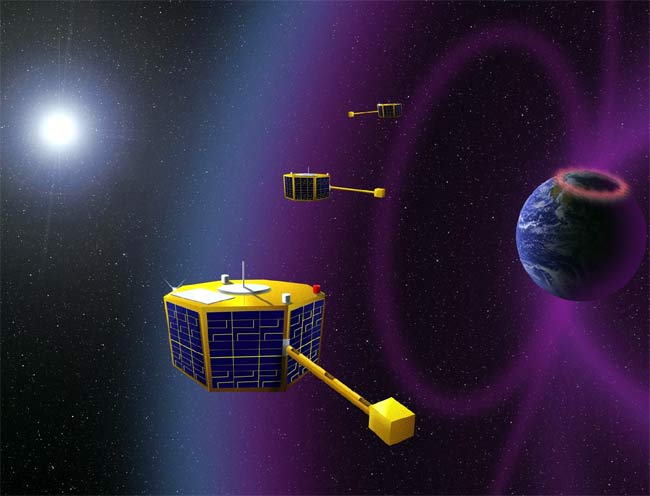Technology Test: NASA Microsats Set for Launch

NASA will launch a trio of microsatellites later this month to explore Earth's magnetic field and test new technology that could be used in future space science missions.
The Space Technology 5 (ST5) microsatellites will launch from Vandenberg Air Force Base in California on Feb. 28 aboard a Pegasus XL rocket and be placed in polar orbit approximately 3,000 miles (4,500 km) above Earth.
The ST5 mission is part of NASA's New Millennium Program (NMP) created to identify and develop new technologies that could be used in future low cost science missions. Specifically, ST5 is designed to demonstrate the benefits of using multiple spacecrafts to make simultaneous measurements while in different locations.
Each ST5 microsatellite weighs about 55 pounds (22 kilograms), is 21 inches (53 cm) across and 19 inches (48 cm) high. Each is the size and shape of large birthday cake. The satellites are designed to work together but each will carry its own guidance, navigation, propulsion and communication controls.
The mission will be first step in developing missions of 10 to 100 small spacecrafts that would investigate "space weather," the interaction of charged particles from the Sun with Earth's magnetic field.
"We need to deploy 10 or even 100 space weather buoys in Earth-orbit at a variety of distances to arrive at a mature understanding about what exactly are the physical processes behind space weather," said ST5 project scientist Jim Slavin in a press conference today.
Space weather can disrupt satellite communication and navigation and power systems here on Earth and is a concern for NASA when planning space missions. While the ST5 mission will be capable of taking scientific measurements, its main purpose will be to test the feasibility of similar future projects.
Breaking space news, the latest updates on rocket launches, skywatching events and more!
"[ST5] is really a proxy for a more complete suite of particle and field instruments," Slavin said. "It is possible that there is a discovery will be made, but the primary purpose is the technology validation."
- Japanese Group Sees Important Role for Microsatellites
- Powering the Future: Soup-Can Spacecraft and Postage-Stamp Engines
- NASA Plans Team of Mini-Satellites
Ker Than is a science writer and children's book author who joined Space.com as a Staff Writer from 2005 to 2007. Ker covered astronomy and human spaceflight while at Space.com, including space shuttle launches, and has authored three science books for kids about earthquakes, stars and black holes. Ker's work has also appeared in National Geographic, Nature News, New Scientist and Sky & Telescope, among others. He earned a bachelor's degree in biology from UC Irvine and a master's degree in science journalism from New York University. Ker is currently the Director of Science Communications at Stanford University.
